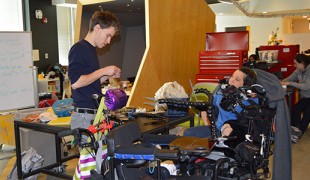- 5994
- 451
- 3
- 13
- 0
- Help Ukraine
About the solution
Because of his condition, Zackary had trouble using computers and going to the web. He even threw the computer mouse in frustration.
Watching this, John tried to find online tools to help with this situation. Since he wasn’t able to find anything, he decided to create his own solution. And that’s how Zac Browser For Autistic Children, a web browser for autistic people, was born.
This online tool helps the user by simplifying the experience of using a computer. It blocks off most websites from view, to block violent, sexual or otherwise adult-themed material. Instead, it presents a hand-picked slate of choices of content from free, public websites, with an emphasis on educational games, music, videos, and visually entertaining images, like a virtual aquarium.
It helps to make the online experience less overwhelming for the user.
For example, the Zac Browser disables extraneous keyboard buttons lie print screen and turns off the right button on the mouse. That eliminates commands most children don’t need anyway, and it reduces the chance an autistic child will lose confidence after making a counterproductive click.
The Zac Browser is available for free and can be downloaded or run directly from www.zacbrowser.com.
Adapted from: https://bit.ly/37hDsmm
More info: www.zacbrowser.com
This solution shall not include mention to the use of drugs, chemicals or biologicals (including food); invasive devices; offensive, commercial or inherently dangerous content. This solution was not medically validated. Proceed with caution! If you have any doubts, please consult with a health professional.
DISCLAIMER: This story was written by someone who is not the author of the solution, therefore please be advised that, although it was written with the utmost respect for the innovation and the innovator, there can be some incorrect statements. If you find any errors please contact the patient Innovation team via info@patient-innovation.com
-
-
763
-
0
-
17052

Proloquo2Go – App to help people communicate
CAREGIVING
COMMUNICATION: Communicating, whether by speaking, listening, or other means
Social interaction
Paralysis
Autism
Cerebral Palsy
Brain Stroke
Brain Injury (Abscess, Brain Barrier Defect, Brain Contusion, Brain Hemorrhage, Brain Edema)
Assistive Daily Life Device (to help ADL)
Assistive Technology access
App (Including when connected with wearable)
Tremors
Muscle cramps or spasms
Difficulty coordinating movements
Muscle weakness
Difficulty speaking or understanding speech
Trouble with fine motor skills (e.g., writing, buttoning clothes)
Twitching or involuntary movements (myoclonus)
Acquired language impairment (Aphasia)
Promoting self-management
Managing Neurological Disorders
Building Supportive Community Relationships
Promoting inclusivity and social integration
Improving Speech and Communication
Caregiving Support
Clinical Pathology
Medical Genetics
Neurology
Pediatrics
Rheumatology
Netherlands
-
-
-
342
-
0
-
4949

Woman with disability invents assistive technology
CAREGIVING
Grip
Cerebral Palsy
Assistive Technology access
Assistive Daily Life Device (to help ADL)
Tremors
Muscle cramps or spasms
Difficulty coordinating movements
Stiffness or rigidity (difficulty moving)
Paralysis of the legs and lower body
Muscle weakness
Trouble with fine motor skills (e.g., writing, buttoning clothes)
Twitching or involuntary movements (myoclonus)
Restoring mobility
Promoting self-management
Managing Neurological Disorders
Promoting inclusivity and social integration
Caregiving Support
Medical Genetics
Neurology
Rheumatology
United States
-
-
-
347
-
0
-
4255

Collaborator Pierluigi Mantovani creates Evolution Devices - solutions that aim to transform Multiple Sclerosis Management
CAREGIVING
BODY BALANCE: Maintaining body balance
STANDING UP: Standing up from a seated position
WALKING: Walking
Multiple Sclerosis
Assistive Daily Life Device (to help ADL)
Walking Aid (wheelchair/walker/crutches)
App (Including when connected with wearable)
AI algorithm
Body-Worn solutions (Clothing, accessories, shoes, sensors...)
Restoring mobility
Regaining sensory function
Managing pain
Promoting self-management
Preserving Organ Function
Managing Neurological Disorders
Maintaining Balance and Mobility
To improve Treatment/Therapy
Preventing (Vaccination, Protection, Falls, Research/Mapping)
Raise awareness
Caregiving Support
General and Family Medicine
Internal Medicine
Medical Genetics
Neurology
Physical Medicine and Rehabilitation
United States
-
 en
en